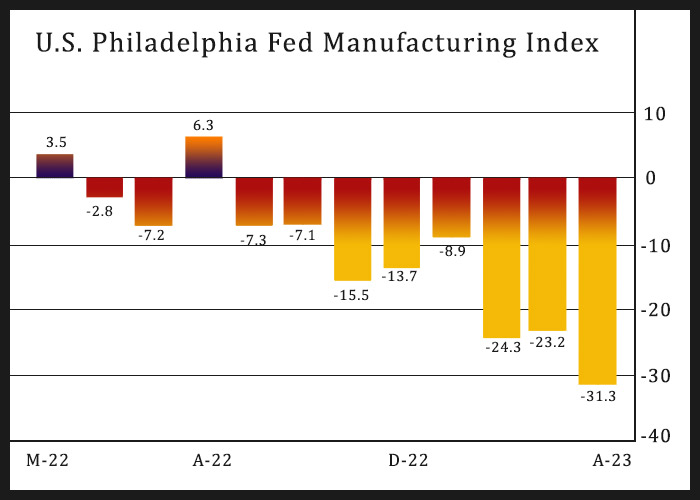Philadelphia-area manufacturing activity unexpectedly contracted at an accelerated rate in the month of April, according to a report released by the Federal Reserve Bank of Philadelphia on Thursday.
The Philly Fed said its diffusion index for current activity slumped to a negative 31.3 in April from a negative 23.2 in March, with a negative reading indicating a contraction. Economists had expected the index rise to a negative 19.2.
With the unexpected decrease, the Philly Fed Index dropped to its lowest level since hitting a negative 43.2 in May 2020.
While 59 percent of firms reported no change in activity, 35 percent of firms reported decreases in activity compared to 3 percent that reported increases.
The new orders index climbed to a negative 22.7 in April from a negative 28.2 in March, although the negative reading still indicates a contraction.
Meanwhile, the report showed a notable slowdown in the pace of contraction in shipments, as the shipments index jumped to a negative 7.3 in April from a negative 25.4 in March.
The number of employees index also improved to a negative 0.2 in April from a negative 10.3 in March, suggesting steady employment overall.
The report also said the prices paid index tumbled to 8.2 in April from 23.5 in March, while the prices received index slid to a negative 3.3 in April from a positive 7.9 in March.
Looking ahead, the Philly Fed said future indicators suggest firms’ expectations for growth over the next six months remain subdued.
The diffusion index for future general activity climbed to a negative 1.5 in April from a negative 8.0 in March.
On Monday, the New York Fed released a separate report showing New York manufacturing activity increased for the first time in five months in April.
The New York Fed said its general business conditions index spiked to a positive 10.8 in April from a negative 24.6 in March, with a positive reading indicating growth. Economists had expected the index to increase to a negative 18.0.
The index for future business conditions edged up to 6.6 in April from 2.9 in March, suggesting firms do not expect activity to improve much over the next six months.
Source: Read Full Article
